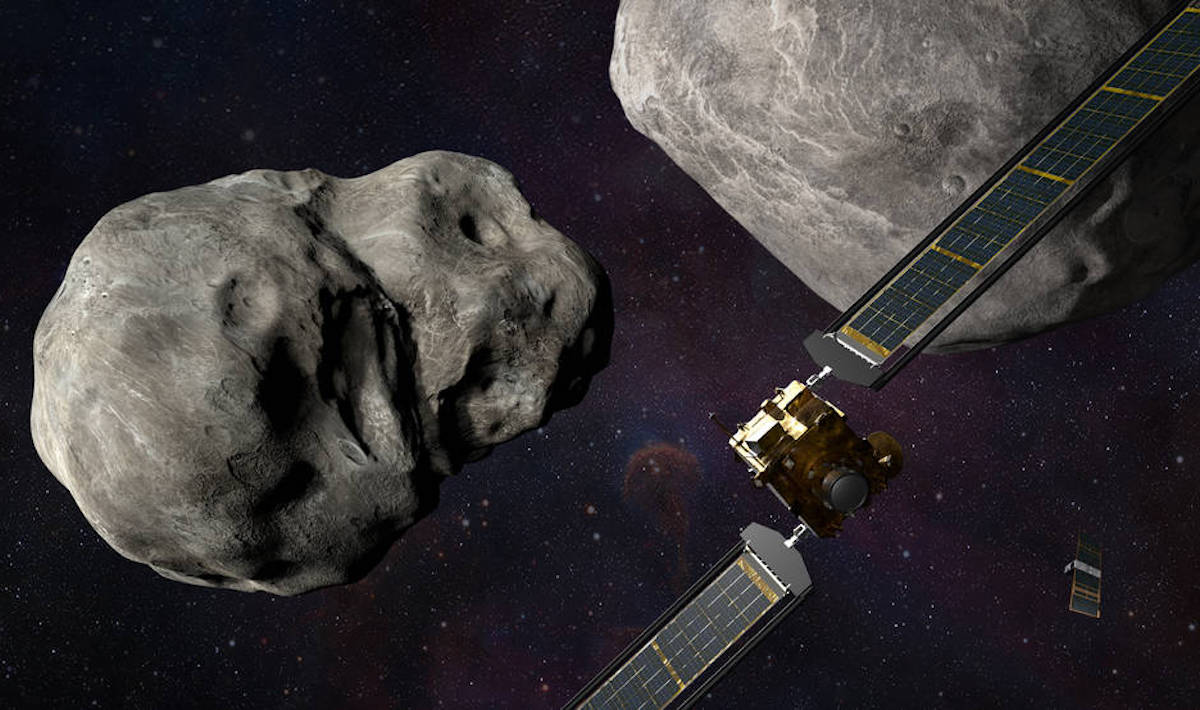NASA Plays Space Billiards with Assist from Santa Barbara Astronomers
DART Mission Will Test Earth’s Ability to Deflect Incoming Asteroids

Right now, Dimorphos, an asteroid moonlet slightly larger than the Great Pyramid of Giza, is quietly minding its own business 6.8 million miles from Earth, slowly orbiting its big brother, Didymos. Little does Dimorphos know, on September 26 at 4:14 p.m. PT, a spacecraft the size of a vending machine launched last November from Vandenberg Space Force Base will slam into it at a screaming 14,000 mph and, if all goes according to plan, nudge the moonlet from its course.
This is NASA’s Double Asteroid Redirection Test, or DART, the world’s first attempt at asteroid deflection in the name of planetary defense. While Dimorphos does not and will not pose any threat to Earth, it is the ideal crash-test dummy for such an undertaking, said Dr. Tim Lister, an astronomer with NASA partner Las Cumbres Observatory (LCO), headquartered in Goleta.
The Didymos-Dimorphos system is an “eclipsing binary,” Lister explained, meaning that from our vantage on Earth, Dimorphos regularly passes in front of and behind Didymos as it orbits. That allows Lister’s team to measure the regular variation in brightness of the system and, consequently, if and how that brightness changes once the test is complete. Even with LCO’s powerful telescopes, Lister noted, the two bodies appear as little more than a pinprick of light against the blackness of space.
For most laypeople, the $330 million question — the cost of the DART mission — is, why? Why expend so much money and energy on such a far-flung endeavor? Are asteroids really that big of a threat? As it turns out, yes.
On the morning of February 15, 2013, an undetected asteroid exploded over Chelyabinsk, Russia, causing a shock wave that struck six cities around the region. The blast injured more than 1,600 people and caused an estimated $30 million in damage. In celestial terms, the Chelyabinsk asteroid was a mere pebble — just 60 feet in size — but the event was a stark reminder of the hazards above.
Sign up for Indy Today to receive fresh news from Independent.com, in your inbox, every morning.
Astronomers estimate there are approximately 25,000 asteroids 500 feet or larger that have wandered outside our solar system’s asteroid belt — either pulled by the long reach of Jupiter’s incredible gravity or knocked out by a chance encounter with another asteroid — and are now lurking within a few million miles of Earth. Those objects are big enough to flatten a city and cause mass casualties should they hit the surface. Scientists are also tracking around 900 asteroids more than 3,000 feet in size, monsters that NASA says are capable of leaving a crater six miles wide and wreaking global devastation.
As the DART spacecraft nears Dimorphos — powered by solar arrays built by Redwire’s Deployable Space Systems, also in Goleta — Lister and his team are gearing up for the big moment. “We’ve been working on this for 18 months,” he said, “so we will be in good shape.” Dimorphos currently takes 11 hours and 55 minutes to orbit Didymos; mission leaders predict the DART collision will slow the orbit by 73 seconds.
Another of the main goals of the test is to determine what type and how much asteroid surface material, called ejecta, blasts into space at the moment of impact. This will help astronomers determine the composition of the moonlet, as they’re still not sure if it’s solid rock or a mass of loose rubble, and how to calibrate actual planetary defense missions, should the need arise. “It’s all important preparation if we need to do this for real in the future,” Lister said.
DART is the latest high-profile NASA operation LCO has contributed to. Earlier this year, its astronomers and their one-of-a-kind network of telescopes that ring the planet helped discover the black hole at the center of our Milky Way Galaxy, and then, a few weeks later, they observed the exceedingly rare event of a star surviving a supernova explosion. “I think it’s a sign of how the observatory is growing and maturing,” said Lister. “The astronomical communities are now aware of who we are and what we do, and the unique capabilities that our network can bring.”
Support the Santa Barbara Independent through a long-term or a single contribution.



